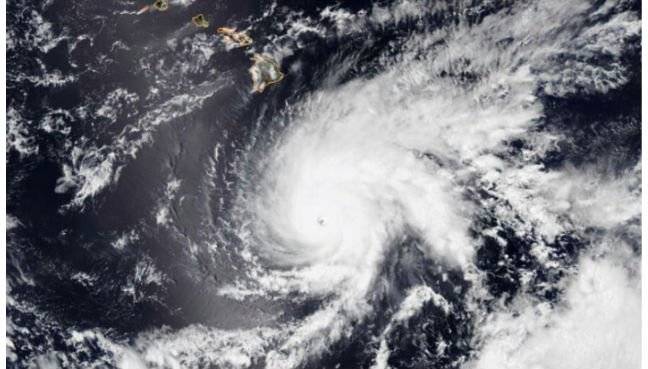Torrential rain pounded Hawaii on Friday as Hurricane Lane crawled toward the island state, triggering landslides and "catastrophic" flooding, while forcing thousands to seek emergency shelter.
By mid-afternoon, Lane was located around 120 miles (190 kilometers) south of the capital Honolulu, but had slowed its north-northeastward progression to a pedestrian two miles per hour.
Experts worry the eye of the storm will pass dangerously close to portions of the central Hawaiian islands later Friday and Saturday before turning westward and away from the danger zone.
"Regardless of the hurricane track, life-threatening impacts will extend far beyond the center position as Lane approaches the islands," the National Weather Center said.
"Excessive rainfall associated with this slow moving hurricane will continue to impact the Hawaiian Islands into the weekend, leading to catastrophic and life-threatening flash flooding and landslides."
Meteorologists have downgraded the system to a Category One storm, with maximum sustained winds of 85 miles per hour.
A tropical storm warning was in place on Big Island, while hurricane warnings remained in place for Oahu and Maui, the two most populated islands.
Brad Kieserman, vice president of Disaster Operations and Logistics for the American Red Cross, told a news conference more than 2,000 people were sheltering in 45 evacuation centers.
"I would not be surprised to wake up tomorrow morning and see evacuation center populations at or above 2,500 or 3,000," he added.
'Whiteout' conditions
Almost 25 inches (60 centimeters) of rain fell on the iconic Waikiki Beach in the last 36 hours, forcing its closure as hoteliers and store owners piled sandbags outside their businesses.
The mainly-rural Big Island -- home to the still-erupting Kilauea Volcano -- has taken the worst hit so far, however, with more than 30 inches of rain in about 24 hours.
Experts warned of "whiteout conditions" -- steam loaded with particles and toxic gases produced when lava hits cool moisture -- as the storm hits.
"The hurricane should not have a significant effect on the eruption aside from minor rockfalls at the summit and increased steaming from Puu Oo and Lerz vents," the US Geological Survey said.
"Whiteout conditions could occur on the new lava field due to steam produced by heavy rain falling on still-hot lava flows."
Meanwhile Brock Long, administrator for the Federal Emergency Management Agency (FEMA), warned of major disruptions to the power grid.
"Citizens need to realize that we are looking at major hurricane impacts and things are going to break," Long said.
"We need to set the expectation that the power could go off for quite some time and the infrastructure is going to be heavily impacted."
Residents across the state have been stocking up on water, food, gasoline and emergency supplies as Lane drew nearer.
'Destructive waves'
Sea levels were expected to rise as much as two to four feet (60 to 122 centimeters) above normal tide levels, causing coastal erosion and prompting a storm surge and "large and destructive waves," forecasters said.
United, Alaska and Hawaiian Airlines have canceled some or all international and domestic flights.
The US Coast Guard says 57,000 US military personnel already stationed in Hawaii are ready to provide logistical and medical support or conduct search and rescue missions operations.
"Hurricane Lane is not a well-behaved hurricane," Governor David Ige said in a statement as he declared a state of emergency earlier this week on the Big Island.
"I've not seen such dramatic changes in the forecast track as I've seen with this storm."
President Donald Trump called Ige, the White House said, to offer support and discuss preparedness and emergency measures.
"The president reiterated that the federal government is fully committed to helping the state in the response and recovery efforts related to Hurricane Lane," the statement said.
Hurricanes rarely make landfall in Hawaii and the last major storm to strike the state was nearly three decades ago, when Hurricane Iniki barreled into the island of Kauai, leaving six dead and causing billions of dollars in damage.
Federal officials have been working with Hawaiian utility managers to keep a close eye on the power grid, a major vulnerability in Puerto Rico last year when it was hit by Hurricane Maria, a Category Four storm.
Hurricane-related deaths in Puerto Rico have been estimated at as many as 4,600 people, largely because prolonged and widespread power outages and washed out roads prevented access to health care, US researchers said.






